Complete an Ironman: Update 7 – Fuel & Nutrition
This is one of 14 updates about my 2014 challenge to complete an Ironman – you can see a list of the others here.
Today I am going to talk about what I eat during training rides and between them. I am also going to share some insight from my time working with professional athlete & All-Pro NFL Tight End, Tony Gonzalez, who is passionate about nutrition and attributes a lot of his success to it.
But first, a training update:
Training Data
I cracked the 300 hour mark. I’ve also surpassed 2,500 miles.
July was a solid month. I’ve now gotten used to 100+ mile bike rides and my long run is up to 19 miles at 7:45 pace. I am injury free so far and lingering pains from past injuries aren’t bothering me much.
Recently my weeks have become extremely intense. I now have two long days per week and four quality days, that doesn’t leave much time for rest. Last week I pushed a little too hard on the quality days and when I tried to start my long run, realized my legs were too heavy and ended up running a few easy recovery miles instead.
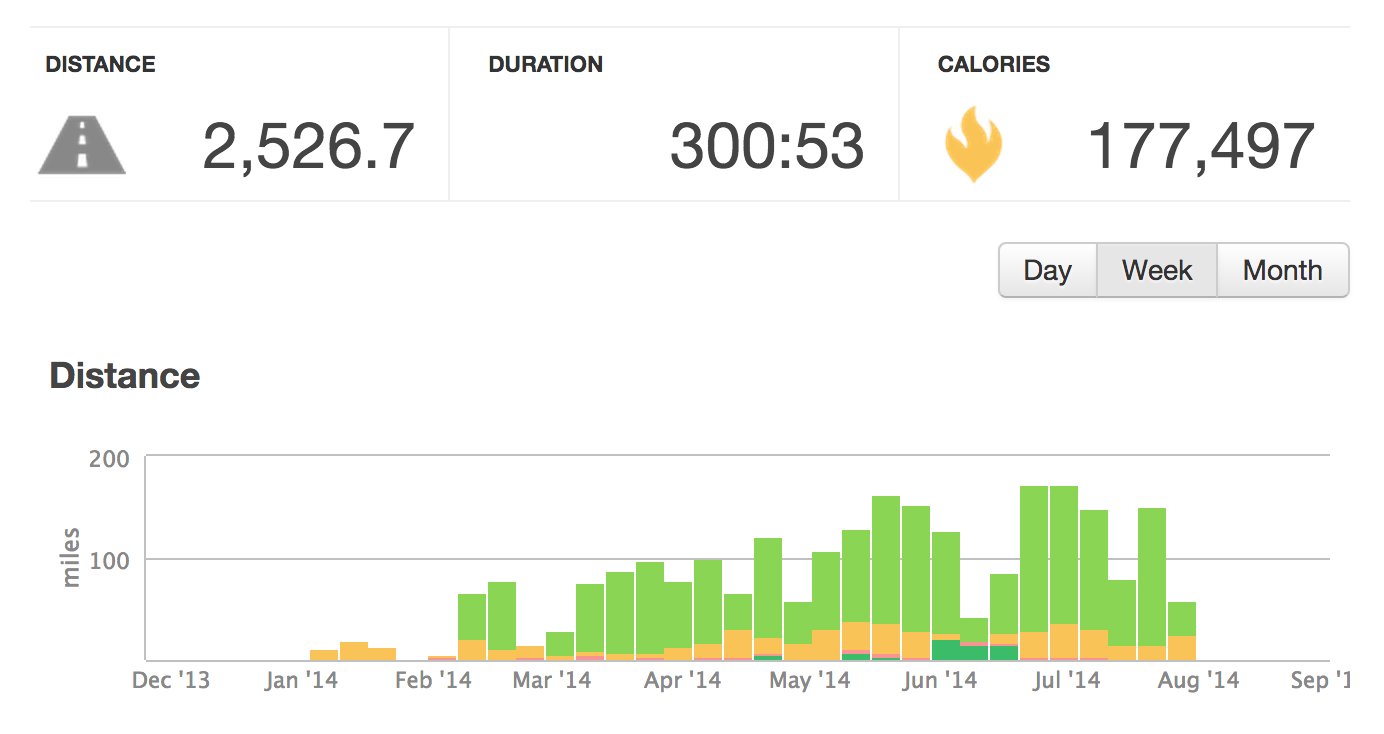 Two weekends ago I raced in the Escape from the Rock duathlon. The course was a 1.5 mile point-to-point swim from Alcatraz to the San Francisco Aquatic Park, followed by a ~7 mile run to the Golden Gate Bridge and back.
Two weekends ago I raced in the Escape from the Rock duathlon. The course was a 1.5 mile point-to-point swim from Alcatraz to the San Francisco Aquatic Park, followed by a ~7 mile run to the Golden Gate Bridge and back.
I finished middle of the pack in the swim and had the second fastest run time of the day. In the chart below I am the red dot. You can see below that it was a swim heavy event – which makes sense due to the special nature of the swim course.
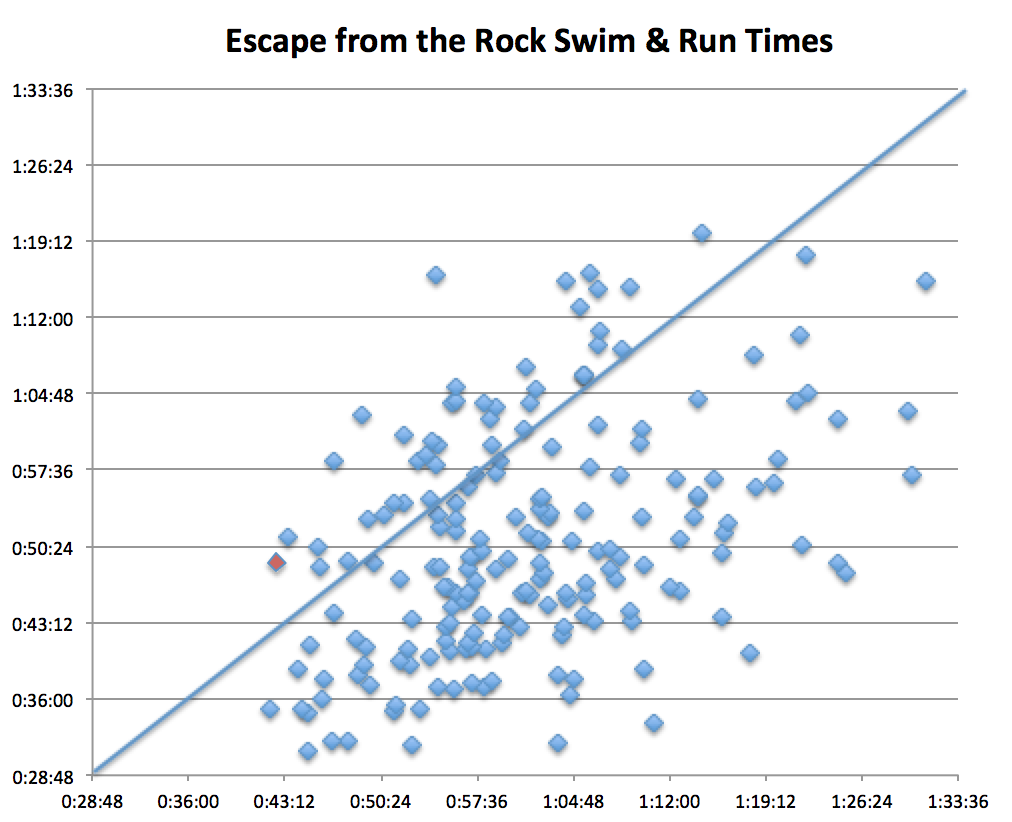
I am a bit disappointed with my swim, which was slower than my practice triathlon from a few months ago. I haven’t been swimming as much lately which is likely partially to blame for the poor result. I think the real culprit was open water navigation and pack swimming. Those are areas I need to work on in the next month.
The run on the other hand was great, I held a fast pace the whole time (~6:00 miles), dug deep and finished exhausted – all areas I had previously mentioned I needed to work on. I’m glad to see that my hard work on the track has paid off and that I’m back to a place where I can lean on my running as a strength.
While this event, that favored swimming, was rough on my ego, I’m not discouraged because the Ironman has only 1.6X the swimming as this event but 3.75X the running. Plus there is the 112 miles of biking, which I am strong at and and which I have been focusing between 60-70% of my training effort lately. The skew will be much more in my favor come race day.
Nutrition and the Ironman
When discussing the topics of fuel & nutrition for an Ironman, there are two distinct areas to focus on: while training & outside of training. The former involves everything I eat while working out or immediately after. The latter is my everyday eating habits – which as you would expect, have changed dramatically since I started training for this race.
Fueling During Training & Racing
A common question I am asked by friends who haven’t done triathlons is ‘do you eat during the race?’. The answer is of course yes.
While racing I will burn between 8,000-12,000 calories. That is more than my body has stored in easily accessible forms. I will also be sweating a lot, literally gallons of sweat throughout the day. I will need to be replenishing my body to replace some of the calories, water & electrolytes I lose, so that I don’t run out of steam before the finish.
The Science of Fueling
Why am I talking about science? Because there are a few bottlenecks in the whole process of turning energy & oxygen into speed and ignoring those will result in Ironman failure.
I want you to understand that the Ironman is a full body race more than many other events you’re familiar with. It strains the arms, legs and core – that should be visibly obvious, it also tests the heart and lungs to deliver oxygen, and of course it challenges the mind, but you might not have realized how involved the stomach, intestines and liver are in a solid race performance.
When I train, it might look like I’m training my legs, heart & lungs, but in fact I am also training my:
- liver to process calories faster and convert food into energy
- muscles to use energy efficiently so each molecule contributes more
- blood & muscles to store more energy so that I have a bigger pool to draw from
For most of my race I will be operating aerobically, meaning I’ll have sufficient oxygen in my body. When your body is an a state of oxygen surplus, fat is one of the best sources of energy. The body can break down fats stored in your blood & under your skin and turn them into energy. You have a lot of fat energy stored in your body. Even a skinny guy like me has thousands of calories of fat stored in my body at any given point. A seriously obese person might have enough fat calories to survive them a full year, so long as they get vitamins and water from outside sources. Pretty crazy.
The problem with depending on fat during a race is that the process of turning fat into energy is slow, so you can only use so much.
There is a second source of energy though, glucose which is stored in your body as glycogen. This is an extremely available source of energy, the problem is you don’t have quite as much of it stored in your body. The good news is it can be replaced by eating carbohydrates, but that is where we come to a bottleneck. The liver can only process so much per hour. That is why it is important to train the liver to increase its throughput and train the muscles to work more efficiently.
My race plan involves running a fairly constant pace. When you split a race evenly like that, the first part feels really easy and the later parts feel really hard. During those first parts, I will likely be getting close to 50% of my energy from fat. As the race progresses and I have to work harder to maintain the same pace, I’ll be drawing more and more energy from glycogen. By the final mile of the marathon I will probably be running off of 90% glycogen & 10% dreams.
If everything goes as planned I will hit the finish line with almost nothing left in me. If things don’t go according to plan I’ll end up with systemic glycogen depletion and have to crawl across the finish line.
So you see, science is important and understanding how energy is used is used is important before we talk about refueling.
What I Eat
My fuel consumption during training and races generally falls into these categories:
- Calories (Further broken down into carbohydrates, protein & fats)
- Water
- Electrolytes
While training I have gotten my body used to processing about 350-500 calories an hour so that in the race I can consume about 4,000 calories on the course. I’m not exactly sure how efficient my liver is, but I know I can eat that much without feeling bloated, so I think I’ve found an appropriate level.
Now that I’ve figured out my calorie goal – the tricky part is figuring out what to use for those 4,000 calories.
I have tried almost every one of the above products as well as a handful of other options. Most of what you’re looking at are single serving packets of bars, gels, gummy chews & waffles (seriously, waffles). Most of those have about 100-250 calories per pack and they tend to either be carbohydrate options or blended options with carbohydrates & proteins.
After months of testing, I’ve decided to go with a liquid nutrition plan leveraging Hammer nutrition’s products. There are three reasons for that:
- It is easy to consume while moving fast. It is really hard to open a packet of gummy chews one handed while remaining tucked in aero position and going 20+ MPH, but it is pretty easy to drink from a bottle.
- It is easy to spread out the intake throughout the race evenly. I mentioned above that the liver is one of the bottlenecks. So I don’t want to eat a big 500 calorie sandwich at 8 different points in the race. It would be much better for me to get 50 calories every 10 minutes, so that my body can slowly absorb and process it. That is pretty easy to do from a bottle where I control the size of my sip.
- Hammer nutrition sits better in my stomach. A lot of that has to do with avoiding artificial flavors & preservatives as well as using less sugar. GU for instance has 6-7 grams of sugar per serving while Hammer Gel only has 2 grams.
For calories I will mainly rely on Perpetuem – a drink mix that contains a lot of carbohydrates but also some protein and fats. It comes in a powder that you can mix with water to make a shake. I have been mixing the bottle in the multi-serving way so that it is much more dense. That means more calories and less weight – plus I can do a whole ride off of one or two bottles. I usually put about 7 servings into my 24oz bottle so that it has ~1,900 calories. It is about the consistency of a milkshake but just thin enough that it comes out of the bottle’s mouth easily.
I’ve been supplementing that with a little bit of Hammer Gel that I keep in a small ‘flask‘. I mainly do this to change the flavor in my mouth and add some variety. Perpetuem has a bit of a milky flavor that doesn’t sit too well, even after washing it down with water. The gel is a nice way to make sure I have a nicer fruity taste in my mouth for between sips.
For water I am going with… water. Regular water. Nothing fancy. During the race there will be volunteers handing out water bottles and I intend to leverage them. I’ll end up drinking between 1-2 gallons, but plan on never carrying more than 1/4 gallon at any given time because water is heavy.
For electrolyte replacement I am going with Hammer’s Endurolytes product, though I have not decided if I’ll go with the pills or the Fizz tablets. The pills are convenient because of how small they are, but the fizz taste good and can be taken in at a more regulated pace with less fumbling around. My handlebar water bottle actually has two compartments, so I’ve been putting water in the big one and water with Endurolytes Fizz in the other. I will likely repeat that in the race.
Fueling Ouside of Training & Racing
A few years ago I worked with NFL All-Pro Tony Gonzalez. There are two big things I took away from my time working with him about nutrition and fuel.
Big cars need a lot of fuel
Tony is 6’5″ 250lbs and runs full speed into linebackers for a living. One day at lunch we were at one of those sushi places where boats come around with little plates on them. The way it works is as you finish an item you stack up the plate to the side & grab another. When you’re done, they charge you based on the number & color of plates at your table.
Towards the end of the meal Tony looked over and razzed me a bit. “Is that all you’re gonna eat?”. I had maybe 10 plates in front of me. He was sitting behind a Lego-esque fortress of 25-30.
The thing about big cars is they need a lot of fuel to go. This was during the summer when Tony was bulking up for the season by working out for a few hours each day. He needed a ton of calories to replace what his body was using and to maintain the muscle mass he had put on. I was meanwhile in the middle of a six year break from running and didn’t need much fuel.
Running an Ironman is not very much like being an NFL player in most regards. I doubt there are that many people that cross over and do both. But despite that, both require an extremely fine tuned body that is capable of putting up with the intense demands placed on it. Being in the NFL requires mass and explosive muscle – big power. Competing in Ironman races requires tons of energy stored away – big fuel reserves.
So expect to eat a lot if you ever want to train for an Ironman.
I’m willing to bet that if Tony and I were to go out for sushi now that I’m in the middle of training, I’d have a few more plates on the table than him. (And if you read this Tony, that is a challenge I’ll back up.)
I mentioned above that the two sources of energy during a race are fat and glycogen. Both are stored in the body and everyday on my training run I deplete them. Then I go home and eat so that I can restore them before the next day’s workout.
I estimate that I consume about 5,000 calories on a normal day. On the weekends when I do my long run & ride, that might get up to 8,000.
I get those calories by eating four meals per day and then try and get a few high calorie snacks in at other points. I’ve been known to chug a 600 calorie shake before bed just to get a bit more in for the day. The meals I eat are about twice a normal serving. If I eat at a restaurant I usually order two entrees or one entree and two extra sides.
I’m not much of a food picture taker, but I snapped a few recently to share with you what a normal meal looks like for me.
I don’t eat fast food that often, but when I do, it is two meals worth.
Some of you might look at this and think it is awesome. I sometimes enjoy being able to eat a lot, but mostly food feels like work. I have to force so much down. I often feel bloated and the only time I don’t is when I’m about to head out on a workout. It isn’t as glamorous as it seems.
High performance cars need high octane fuel
If you don’t watch the NFL you might not know that Tony played for 17 years and retired in good enough shape that most people felt he should keep playing. In a league where the average tenure is three years, that is impressive.
Genes certainly played a part in that, but Tony attributes a lot of his success to his nutrition.
He once described the professional athletes body as a high performance car. And like an exotic car, it should only run on the best fuel. Junk in, junk out. Because of this, his diet consisted of a lot of high quality foods. Grass fed beef, free range chicken, organic vegetables, etc. Very little processed foods with preservatives.
As I’ve worked to get my body into racing shape I’ve tried to apply these principles. I do my best to limit sugar, preservatives and artificial junk food while at the same time making sure I get a good mix of vegetables and that my meats are from high quality sources. I’m not perfect, but I try.
One thing I don’t worry about is fatty food. The more fat the better. Remember that I mentioned above that fat is one of the best sources of energy and that I use a good chunk of my fat stores every day during my workout. In order to replenish that fat I need to consume more. The best sources of fat are oils & nuts, but I don’t mind a bit of dairy and even fat from meats.
Another thing I don’t avoid is carbohydrates. I do try to avoid simple carbs like white sugar and white flower – instead opting for whole grains, Remember, carbohydrates are the second source of energy and one that I likely deplete every day. I need to replenish those energy stores, so I eat lots of whole grain pasta, bagels, breads, etc.
Conclusion
That is basically how I think about food now that I’m training for an Ironman. There is a ton of great reading on this topic, but I wanted to share my personal approach and how I’ve applied it to my training plan.
Remember, fueling is a pretty personal thing. Every body is a bit unique and might need tweaks to a recommended plan in order to find something that works. The best way to find a good nutrition plan is to do what I did and test it out during training. Based on allergies, genetics and what your gut is used to, different options might be better for you.
Hopefully this example can help answer a few questions though and point you in the right direction. If nothing else, you now know what an Ironman (hopeful) eats.

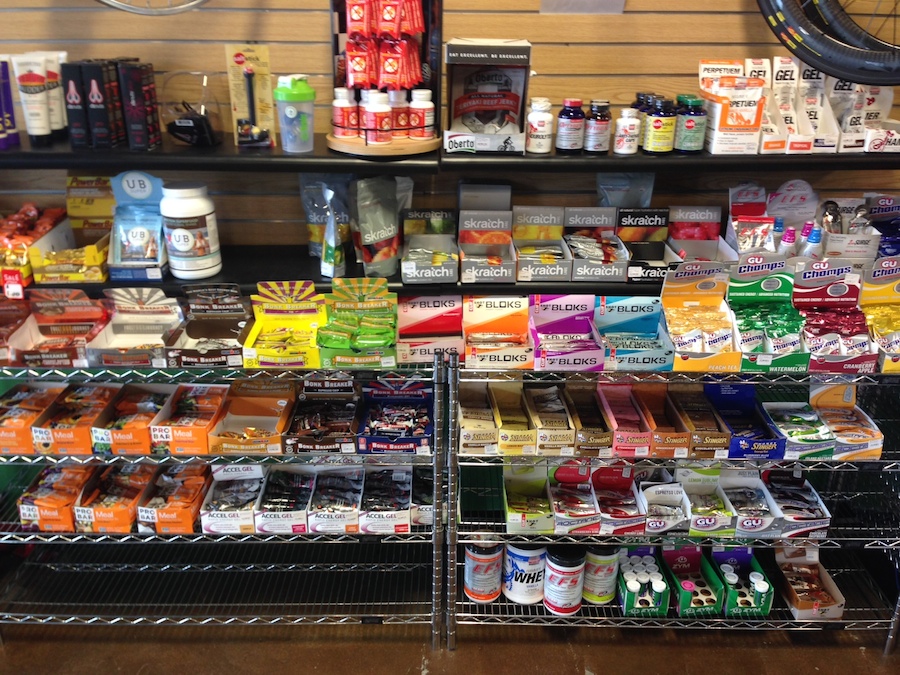
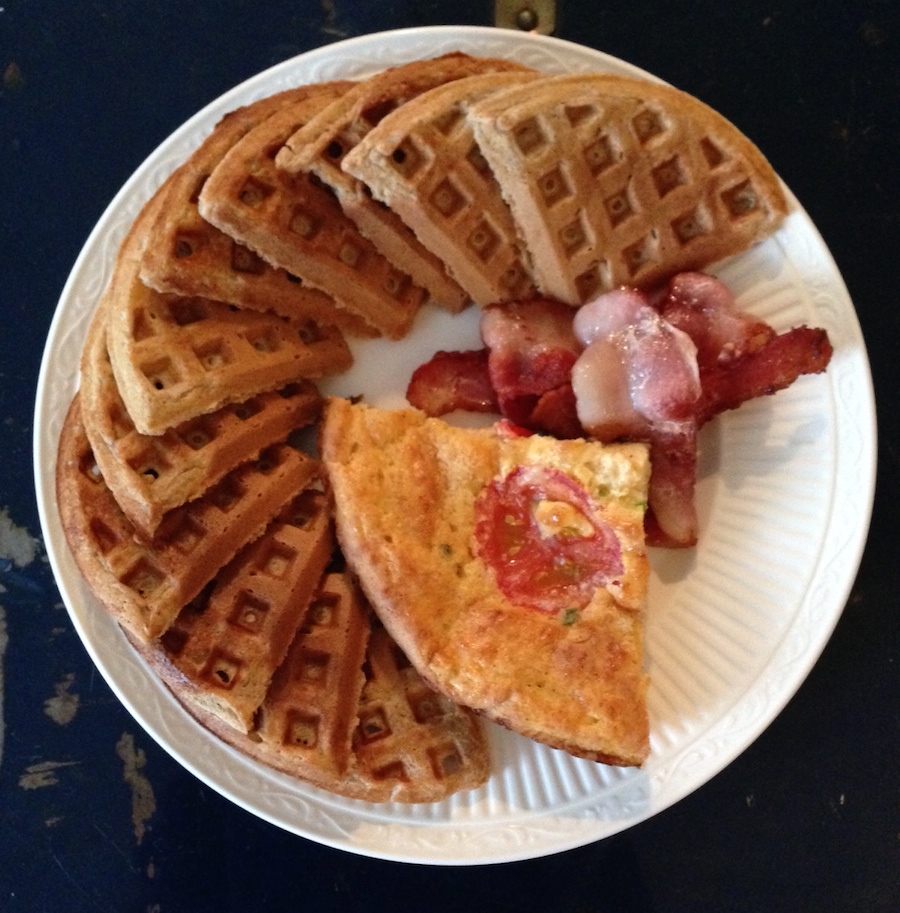

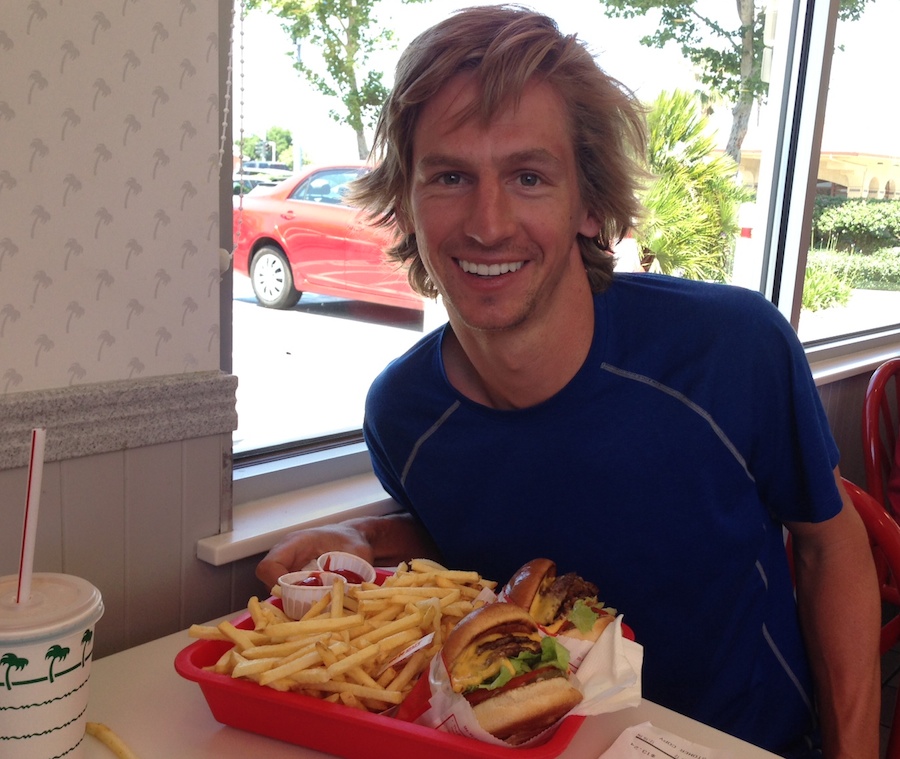
One thought on “Complete an Ironman: Update 7 – Fuel & Nutrition”